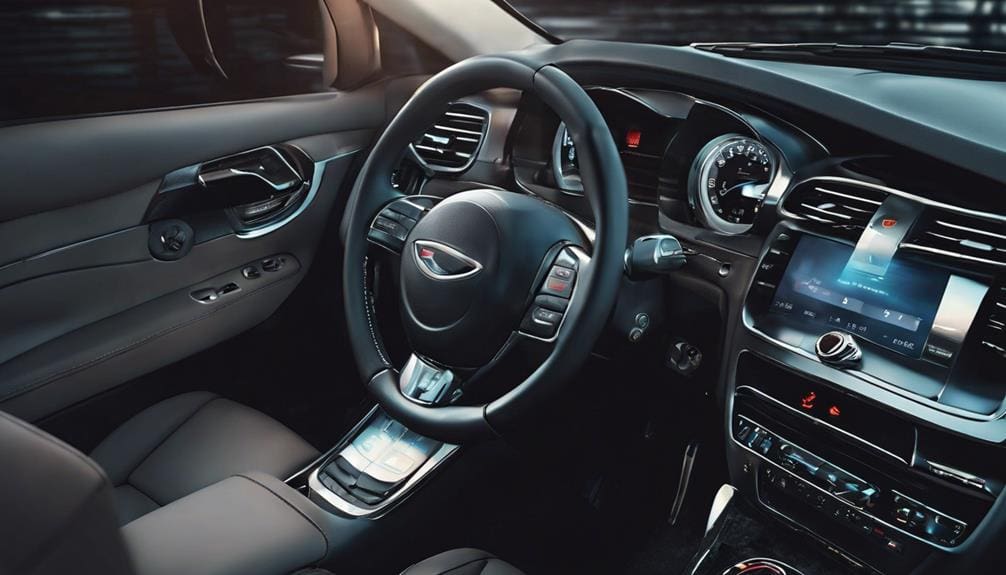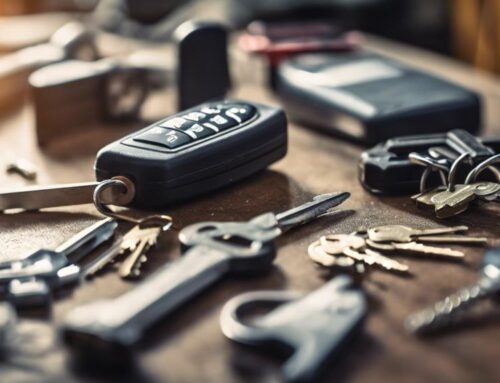To determine if your vehicle has a keyless entry system, start by examining the key fob. Use an RF signal detector set to scan 300-433 MHz. Press a button on the fob and confirm an RF signal. Inspect the driver’s side door for a numeric keypad and test it with a known code. Try the push-button start to see if the engine ignites without a key. Check for proximity sensors on door handles and observe if doors open as you approach. Finally, consult your vehicle’s manual or decode the VIN for detailed features. For more precise identification techniques, continue onward.
Key Takeaways
- Check the vehicle manual under ‘Keyless Entry System’ for specifications and features.
- Inspect door handles for small, recessed areas or button-like structures indicating proximity sensors.
- Test the key fob within 30 feet range to confirm remote lock functionality.
- Look for a push-button start system that operates without inserting a key.
- Use the VIN number to access detailed vehicle feature specifications from the manufacturer or third-party services.
Recognizing Key Fobs
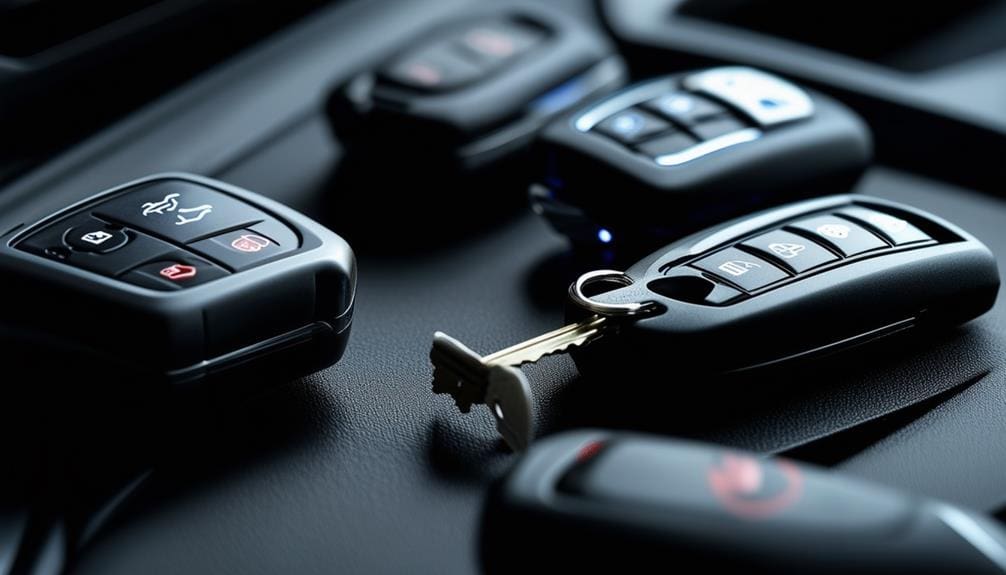
To identify key fobs, first pinpoint the unique frequency they operate on by using a radio frequency (RF) signal detector. Start by setting your RF signal detector to scan for frequencies typically utilized by key fobs, which range between 300 and 433 MHz. Hold the detector close to the suspected key fob and press any button on the fob. The detector will show the presence of an RF signal, confirming the fob’s operating frequency.
Next, analyze the data output from the RF signal detector. Take note of the exact frequency and modulation type. Key fobs commonly use amplitude shift keying (ASK) or frequency shift keying (FSK). Make sure your detector can distinguish between these modulations. This step is essential for accurate identification.
After confirming the key fob’s frequency and modulation, compare these specifications with established key fob frequencies for different vehicle manufacturers. This will assist you in determining the fob’s compatibility with your vehicle. Maintain a detailed record of frequencies and modulation types for future reference.
Checking Your Vehicle Manual
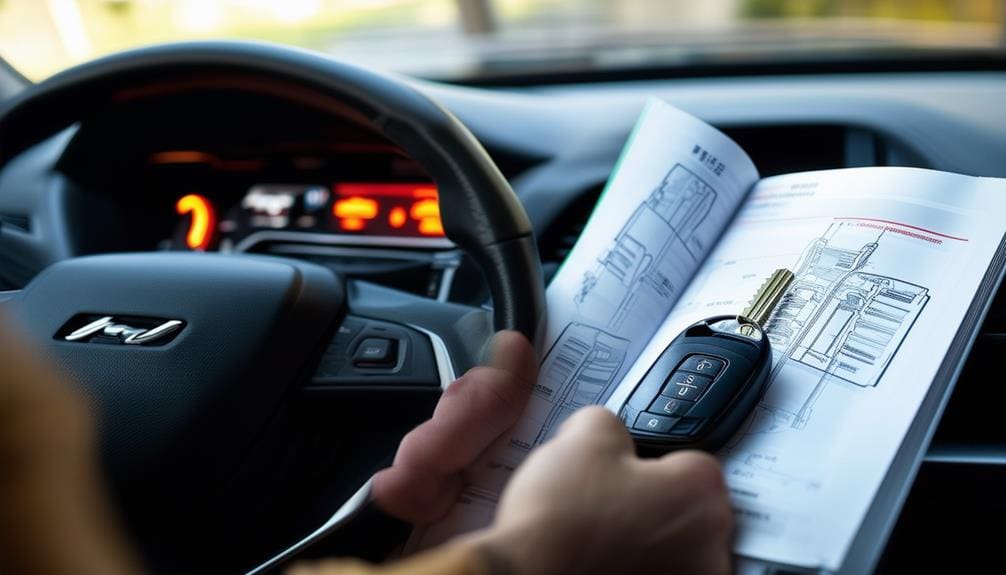
Refer to your vehicle manual to locate the section detailing the keyless entry system specifications and troubleshooting procedures. This section is essential for understanding the mechanics and capabilities of your vehicle’s keyless entry system. The manual will often provide detailed technical information, including the frequency range of the key fob, battery type, and steps for reprogramming the system if needed.
To efficiently navigate your manual, follow these steps:
- Identify the Table of Contents: Locate the ‘Keyless Entry System’ or ‘Security Features’ section.
- Review System Specifications: Look for technical details such as frequency bands, signal encryption, and range.
- Troubleshooting Guide: Examine common issues and diagnostic steps for system malfunctions.
- Battery Replacement Instructions: Find the section on how to replace the key fob battery, including type and installation.
- Reprogramming Procedures: Learn how to reprogram your key fob if it loses synchronization with the vehicle.
Identifying Keypad Entry
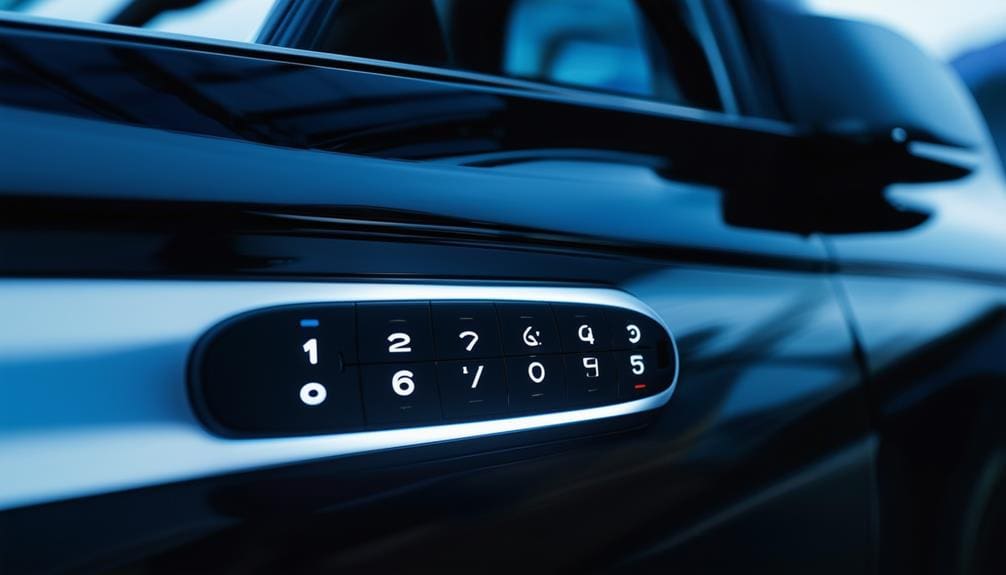
After consulting your vehicle manual for keyless entry specifications, you should next identify if your vehicle is equipped with a keypad entry system by inspecting the driver’s side door for a numeric keypad. This diagnostic approach is essential for confirming the presence of this advanced feature. Carefully examine the area near the door handle and along the door panel. The keypad typically consists of a series of numbers, often illuminated for nighttime visibility.
Once you locate the keypad, verify its functionality by entering a known code or the default factory code found in your manual. If the keypad responds correctly, your vehicle is equipped with this feature. Additionally, the presence of a keypad entry system often correlates with other advanced electronic features.
| Diagnostic Step | Action Required |
|---|---|
| Inspect Driver’s Side Door | Look for numeric keypad near handle |
| Verify Keypad Presence | Locate series of numbers on door panel |
| Test Keypad Functionality | Enter known or factory code |
| Confirm Illumination | Check if keypad lights up at night |
| Correlate Features | Identify other advanced electronics |
Testing Remote Lock Features
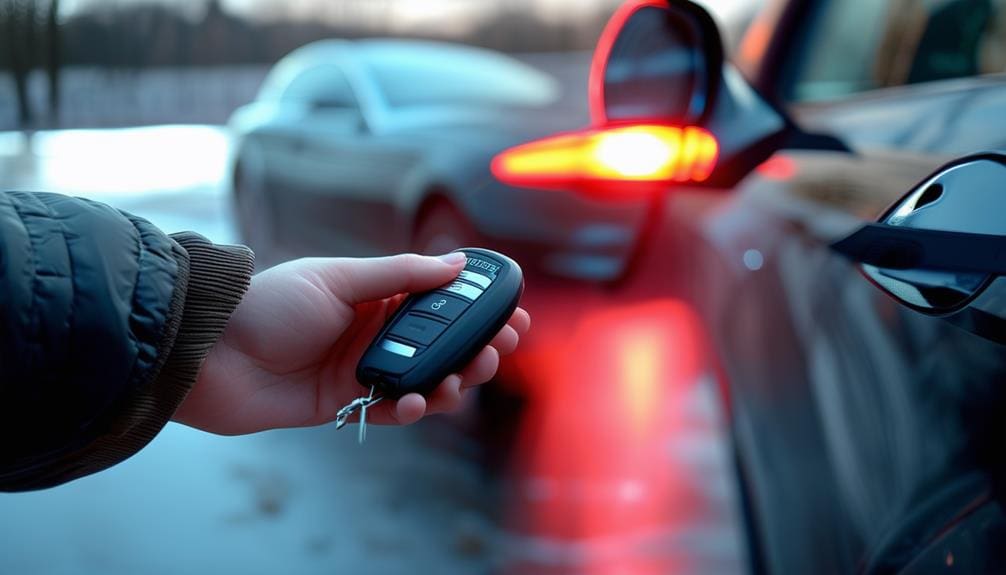
When testing your vehicle’s remote secure features, start by confirming the key fob’s battery is fully charged and in good working condition. Begin by standing within the specified range, typically around 30 feet, and press the lock button. Observe the vehicle’s response closely.
- Secure Confirmation: Check for visual indicators such as flashing lights or audible signals like a horn chirp.
- Proximity Sensitivity: Approach the vehicle while repeatedly pressing the secure button to gauge the range of effectiveness. Note any delays or inconsistencies.
- Multiple Entry Points: Test each door, including the trunk, to ensure they all secure and secure in unison when the remote button is pressed.
- Signal Interference: Identify any potential sources of interference, such as other electronic devices or physical obstructions, that might affect the signal.
- Manual Override: Verify that the physical key can override the remote secure system by manually locking and securing the doors.
Document any anomalies or failures in these tests for further diagnosis. By systematically testing these remote secure features, you can confirm the operational integrity of your keyless entry system and identify areas that may require attention.
Exploring Push-Button Start
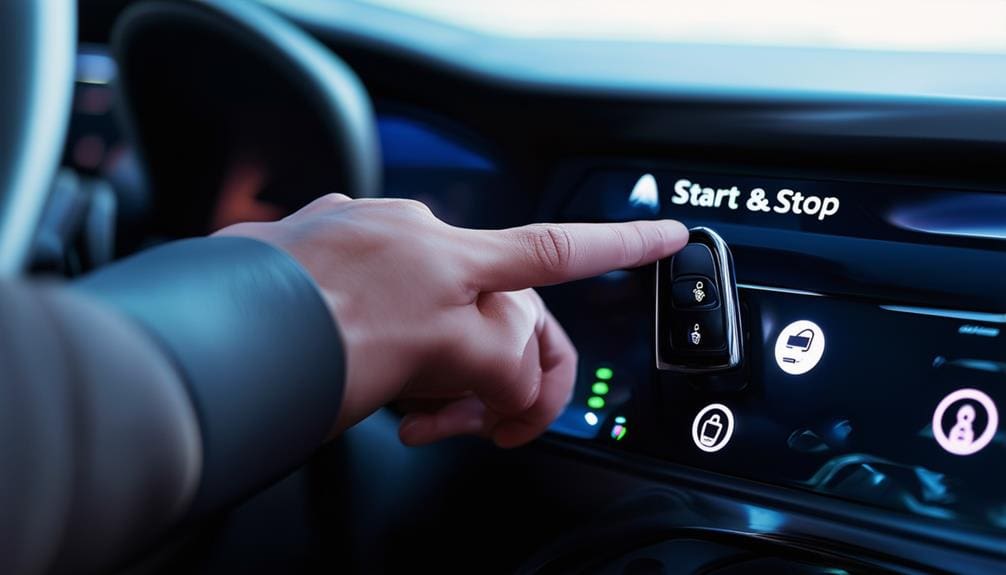
You’ll need to identify push-button start features by examining the vehicle’s ignition system interface. Assess the benefits by noting the enhanced security, convenience, and reduced wear on mechanical parts. Confirm functionality through diagnostic tools to guarantee system reliability and user authentication.
Identifying Push-Button Features
Examining the push-button start system involves understanding its key components, including the start/stop button, proximity sensors, and the vehicle’s electronic control module (ECM). First, locate the start/stop button, typically found near the steering column or center console. This button is your primary interface for the system.
Next, inspect for proximity sensors. These sensors communicate with your key fob to verify the vehicle only starts when the fob is within a specific range. The ECM integrates all signals and authorizes the engine start.
To identify if your vehicle has a push-button start, follow this diagnostic checklist:
- Start/Stop Button Presence: Check if there’s a dedicated button labeled ‘Start’ or ‘Engine Start/Stop.’
- Proximity Sensors: Look for sensors near the door handles or inside the cabin that detect your key fob.
- Key Fob Design: Validate if your key fob has buttons for locking/unlocking but no physical key.
- Dashboard Indicators: When pressing the start button without the fob, notice any dashboard warnings indicating ‘Key Not Detected.’
- ECM Diagnostics: Use an OBD-II scanner to identify ECM codes related to keyless entry systems.
Benefits of Push-Button Start
Understanding the key components of a push-button start system, let’s now explore the specific benefits this technology offers to vehicle owners. First, the convenience factor is unparalleled. With a simple press of the button, you can ignite your vehicle’s engine without fumbling for keys. This seamless interaction enhances user experience to a great extent.
Secondly, push-button start systems often integrate with advanced security protocols, reducing the risk of theft. These systems use encrypted signals and proximity sensors that only respond to your specific key fob. This guarantees that unauthorized access is nearly impossible.
Thirdly, the technology contributes to the longevity of your ignition system. Traditional key-based ignitions experience wear and tear over time, but a push-button system minimizes physical contact, thereby extending the life of your vehicle’s ignition components.
Here’s a detailed comparison of traditional and push-button start systems:
| Feature | Traditional Ignition | Push-Button Start |
|---|---|---|
| Key Requirement | Physical Key | Proximity Key Fob |
| Wear and Tear | High | Low |
| Security Level | Basic | Advanced Encryption |
| Ease of Use | Moderate | High |
| Longevity of System | Shorter Lifespan | Longer Lifespan |
Observing Proximity Sensors
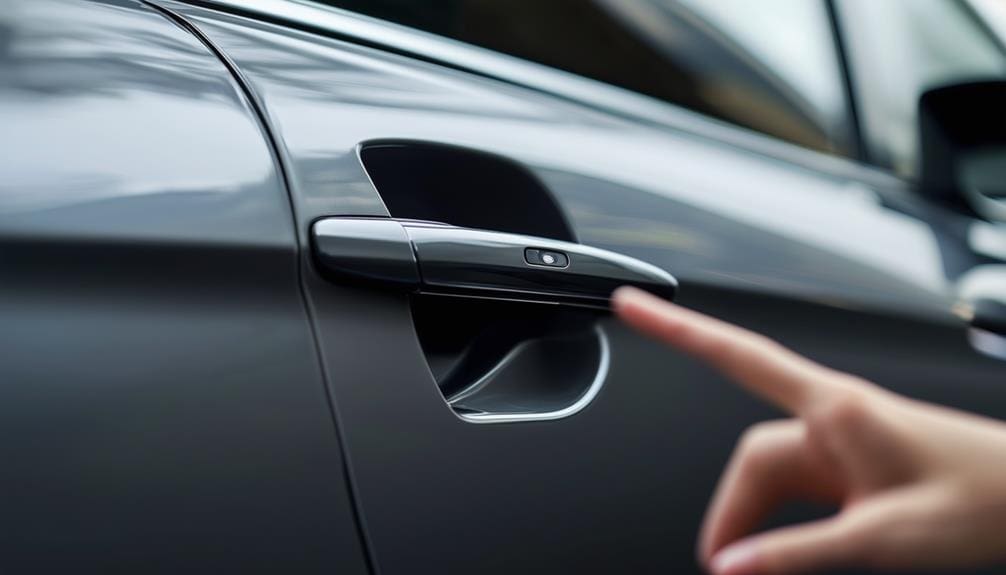
Frequently, proximity sensors in keyless entry systems rely on electromagnetic fields to detect the presence of an authorized device within a specific range. These sensors are integral for seamless vehicle access and are strategically positioned around the vehicle to maximize detection efficiency.
To diagnose the presence of these sensors, follow these steps meticulously:
- Inspect Door Handles: Look for small, recessed areas or subtle button-like structures on the exterior door handles. These often house the proximity sensors.
- Check for Antennas: Proximity sensors often work in tandem with antennas placed within the vehicle’s framework. Look for small, plastic covers or enclosures near the door frames.
- Monitor Lock/Open Behavior: With the key fob in your pocket, approach the vehicle. If the doors open automatically without pressing any buttons, proximity sensors are likely present.
- Engine Start Mechanism: Attempt to start the vehicle without inserting a key. If the engine starts, the system has recognized the proximity of the key fob.
- Consult the Owner’s Manual: Refer to the vehicle’s manual for specific information on keyless entry system components and their locations.
Consulting Vehicle VIN
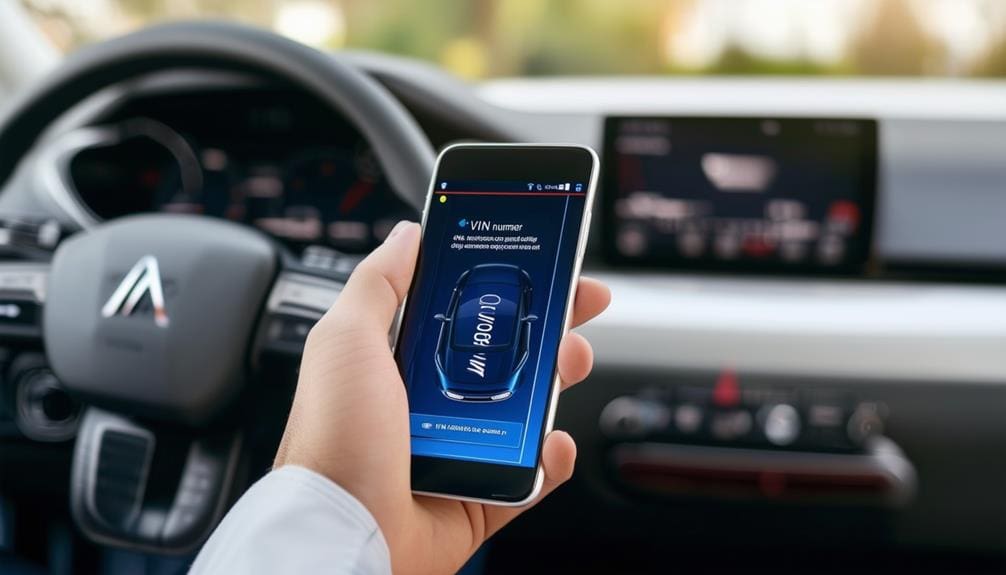
Start by locating the VIN number, typically found on the dashboard or driver’s side door frame. Use authorized VIN information sources to obtain detailed vehicle data. Decoding the VIN will provide essential insights into the vehicle’s keyless entry system specifications.
Locating VIN Number
To locate your Vehicle Identification Number (VIN), check the dashboard on the driver’s side where the windshield meets the dash. This critical alphanumeric code provides essential details about your vehicle’s specifications and history. If the VIN isn’t visible there, you might need to explore other locations, employing a methodical approach.
Here are potential locations to find the VIN:
- Driver’s Side Door Frame: Open the driver’s door and inspect the area where the door latches. The VIN is often on a sticker or metal plate.
- Engine Compartment: Look on the front of the engine block. Manufacturers sometimes stamp the VIN on the engine for security.
- Under the Hood: Check the front of the vehicle frame. It may be etched on a metal plate near the radiator or shock tower.
- Vehicle Registration Documents: The VIN is always listed on the car’s registration and insurance papers.
- Driver’s Side Inner Wheel Arch: Occasionally, the VIN is placed inside the wheel arch, viewable only when the wheel is turned inward.
VIN Information Sources
Accessing your VIN’s wealth of information involves consulting several key sources, starting with the National Highway Traffic Safety Administration (NHTSA) database for vehicle recalls and safety issues. Navigate to the NHTSA website, enter your 17-character VIN, and retrieve detailed data on manufacturer recalls, safety notices, and compliance details. This repository is indispensable for ensuring your vehicle’s adherence to safety standards.
Next, leverage the resources of your vehicle’s manufacturer website. Most OEMs (Original Equipment Manufacturers) provide detailed build sheets and feature specifications via their online portals. Input your VIN to access intricate details about your vehicle’s original configuration, including whether it includes a keyless entry system.
Additionally, consider using third-party services like Carfax or AutoCheck. These platforms aggregate data from DMV records, insurance companies, and service shops. By entering your VIN, you can generate a detailed report that might highlight the presence of keyless entry features among other technical specs.
Lastly, your local dealership is a valuable source of VIN-specific information. Provide them with your VIN and request a Vehicle Information Report. Dealerships have proprietary databases that can uncover hidden details about your vehicle’s features and history, giving you authoritative insights into its keyless entry capabilities.
Decoding VIN Details
After gathering your VIN from trusted sources, you’ll need to decode its alphanumeric sequence to uncover specific details about your vehicle’s keyless entry system. The VIN (Vehicle Identification Number) is a 17-character string that serves as your vehicle’s fingerprint. By consulting a VIN decoder, you can access a wealth of information.
Here’s a step-by-step guide to help you decode your VIN:
- Locate the VIN: Typically found on the driver’s side dashboard near the windshield or inside the driver’s side door frame.
- Use a Reliable VIN Decoder: Online tools like the NHTSA VIN Decoder or manufacturer-specific decoders are ideal for detailed information.
- Decode Positions 1-3: These characters identify the World Manufacturer Identifier (WMI), revealing the vehicle’s manufacturer and country of origin.
- Focus on Positions 4-8: These positions provide details about the vehicle’s model, body type, engine type, and other key features, including the presence of a keyless entry system.
- Check the 10th Character: This indicates the vehicle’s model year, which can be cross-referenced with the availability of keyless entry systems for that production year.
Low Rate Locksmith Services
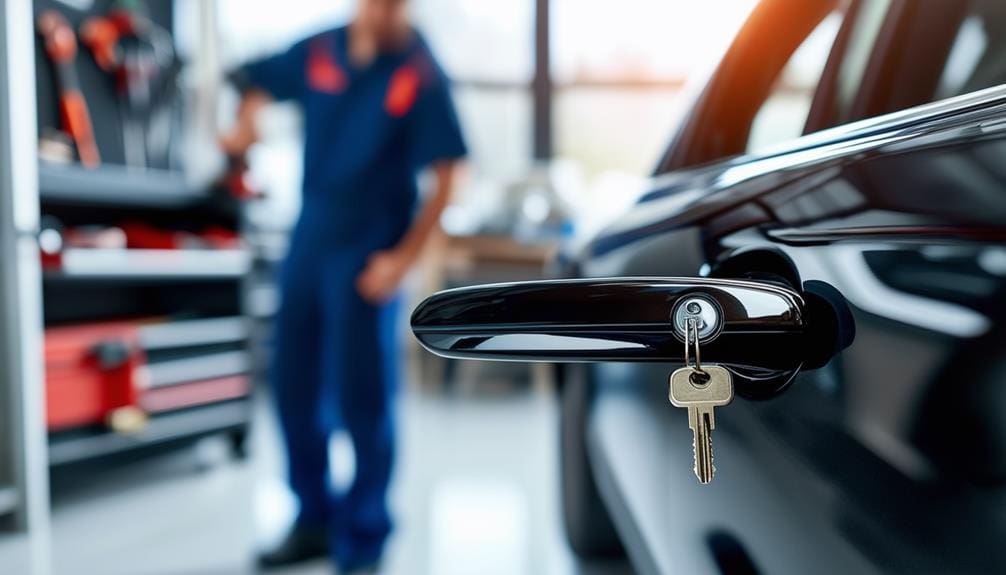
When evaluating low rate locksmith services, make certain they offer thorough keyless entry solutions tailored to your security needs. First, confirm the locksmith’s proficiency with advanced keyless entry systems, such as RFID and remote key fobs. They should be skilled at programming and diagnostics for various makes and models. Request a detailed breakdown of services, including key fob programming, battery replacement, and signal frequency diagnostics.
Next, check if the locksmith uses OEM (Original Equipment Manufacturer) parts or certified equivalents. Substandard components could compromise your vehicle’s security. Additionally, inquire about their tools—state-of-the-art diagnostic devices guarantee accurate programming and system compatibility.
Make sure the locksmith provides a warranty on both labor and parts. A reputable service will guarantee their work, reflecting confidence in their expertise. Ask for a written estimate to avoid hidden charges. Low rates shouldn’t mean low quality; scrutinize reviews and testimonials to gauge reliability and customer satisfaction.
Lastly, prioritize locksmiths who offer emergency services. Keyless entry issues can arise unexpectedly, and a responsive locksmith ensures you’re never stranded. Vetting locksmith services diligently assures your vehicle’s keyless entry system remains secure and functional.
Frequently Asked Questions
Can Keyless Entry Systems Be Installed Aftermarket?
You can definitely install keyless entry systems aftermarket. First, confirm your vehicle’s compatibility. Next, acquire a high-quality system, and follow precise wiring diagrams. Professional installation guarantees peak performance and integrates seamlessly with your vehicle’s existing electronics.
How Does Keyless Entry Affect Vehicle Security?
Keyless entry amplifies vehicle security by encrypting signals between the fob and the car. Make sure you monitor signal strength, maintain fob battery life, and utilize an RFID-blocking pouch to prevent unauthorized access and relay attacks.
What Are the Battery Requirements for Keyless Entry Key Fobs?
Check your key fob manual for specific battery type, usually a CR2032 coin cell. Inspect the battery compartment for corrosion or damage, ensuring ideal signal strength for your keyless entry system’s reliability and security.
Do All Keyless Entry Systems Work the Same Way?
No, not all keyless entry systems operate the same way. You’ve got passive and active systems. Passive systems automatically open; active systems require pressing a button. Diagnostic tools can identify specific system types by scanning vehicle data.
What Are the Common Issues With Keyless Entry Systems?
Common issues include signal interference, battery failure, and sensor misalignment. Diagnose by checking for obstructions, replacing the fob battery, and ensuring sensors are clean. Maintain peak performance with regular checks and swift troubleshooting.
Conclusion
To sum up, identifying your vehicle’s keyless entry system is simpler than cracking the Da Vinci Code. By recognizing key fobs, checking your vehicle manual, identifying keypad entry, testing remote lock features, exploring push-button start, observing proximity sensors, and consulting the vehicle VIN, you can confidently diagnose your system. If all else fails, Low Rate Locksmith Services can swoop in like superheroes to save the day. Now, go release your car’s full potential!

